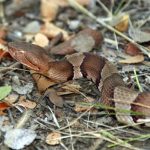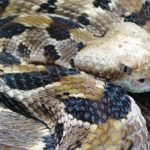

|
Southern Copperhead
- Copperheads prefer well wooded and shaded areas and often make their homes in piles of wood, brush, or large stones.
- These snakes are most active at dawn and dusk, and are usually encountered on bike and foot
- Copperheads are the ones that inflict the most bites on humans due to the fact that they are very common throughout their range and they frequent habitats where people are likely to encounter them.
- When threatened, copperheads will often freeze in place when approached rather than flee due to confidence in their camouflage.
- Fortunately, the bite of this snake is usually the least serious of all those listed here. Copperheads have the least potent venom of any snake in Texas. They also have a tendency to dry bite—to inject little or no venom—when striking a non-prey animal. These factors combined with the copperhead’s small fangs (3/8 inch) help to reduce the danger presented by these snakes.
- Click here to learn more about Copperheads
|
 |
Western Cottonmouth (aka Water Moccasin)
- These snakes usually keep to swampy locations that most people are apt to avoid. This is not always the case, however, and cottonmouths have been encountered in dry areas far from any standing body of water.
- Although these snakes account for very few bites each year, their venom is very potent. Across the United States cottonmouths are responsible for an average of about one death per year.
- When encountered, Western Cottonmouths will go to great lengths to alert you to their presence in order to avoid having to bite. When alarmed or threatened, these snakes will hiss loudly and open their mouths to reveal the white namesake interior as a warning. They will shake the tip of their tail in in dried detritus in order to create a rattling sound.
- If time allows, cottonmouths will coil up, pulling their head back into the center so that only the white of their open mouth is exposed. It can be quite alarming to discover a cottonmouth behaving this way, but it is a strictly defensive posture. When given ample room, most Western Cottonmouths will retreat at the first opportunity.
- Click here to learn more about the Western Cottonmouth
|
 |
Western Diamondback Rattlesnake
- Perhaps the most dangerous of all the snakes on this list. It is very common across all its range, and shows no specific habitat preference. This rattlesnake is active during the day and said to be very bold. All of these factors combine to make encounters with people relatively likely.
- The Western Diamondback Rattlesnake’s venom is a potent cocktail that includes neurotoxins, pre-digestive enzymes, and hemotoxins. This snake is responsible for the majority of serious hospital treated snakebites in Texas.
- Click here to learn more about the Western Diamondback Rattlesnake
|
 |
Timber Rattlesnake (Crotalus horridus)
- Found in the eastern third of the state of Texas.
- The preferred habitat is dense underbrush in bottomland forests, and it is said to avoid developed areas. This tendency results in an uneven distribution across its range.
- This large snake is potentially very dangerous, but it is said to have a mild disposition and usually will provide abundant warning before striking.
- Click to learn more about the Timber Rattlesnake
|
 |
Western Pygmy Rattlesnake
- Sightings of the Western Pygmy Rattlesnake usually occur far to the east of the Dallas/Fort Worth Metroplex.
- They frequent places with dense vegetation near reliable water sources.
- Even though this little rattlesnake is said to be quick to bite, it is not considered very dangerous. The snake’s tiny fangs generally limit its ability to envenomate, and even with a successful bite, the Western Pygmy Rattlesnake does not produce enough venom to deliver a fatal quantity.
- Click here to learn more about the Western Pygmy Rattlesnake
|
 |
Texas Coral Snake
- Although very rare, they can be common in areas near human development, but they are secretive and rarely seen.
- The venom of the coral snake is the most potent of all snakes in North America, and is said to be similar to that of cobras.
- These snakes tend to avoid confrontation with people and bites are rare—usually the result of deliberate and prolonged handling.
- Further, the nature of the Texas Coral Snake’s fangs makes it difficult for the snake to effectively envenomate a human.
- When bites do occur, they should be considered very serious. Only a small amount of coral snake venom can prove to be fatal.
- Coral snakes can sometimes be confused with other similarly colored, but non venomous snakes, like the milk snake. The arrangement of the color bands is a good differentiator. The operative phrase to remember is, “Red touch yellow, kill a fellow. Red touch black, friend of Jack.”
- Click here to learn more about the Texas Coral Snake
|













